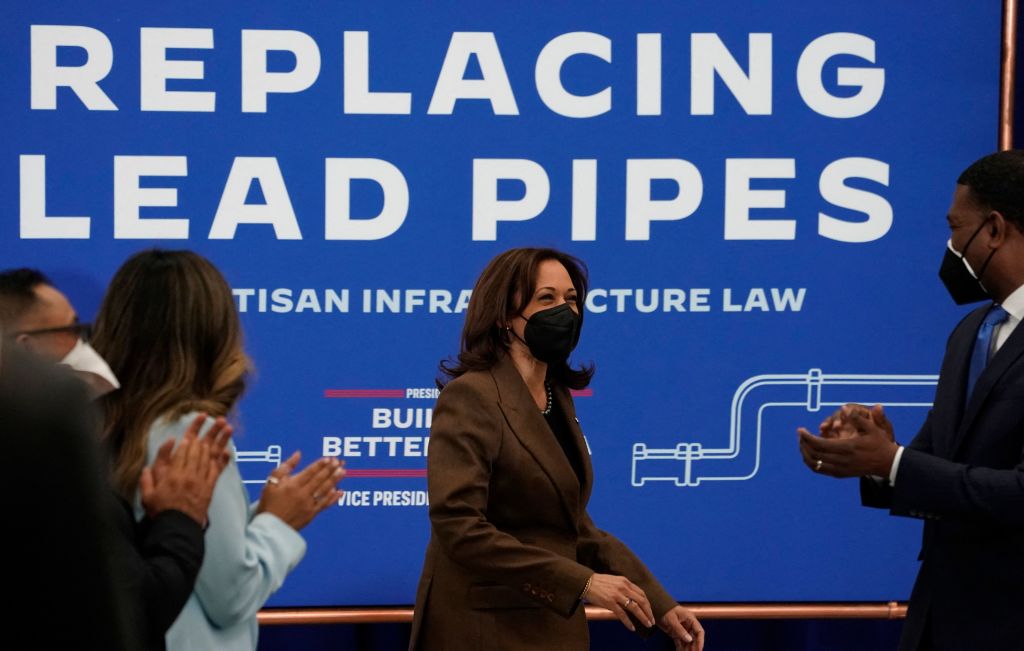CHICAGO—The city’s current goal to remove lead drinking water pipes within half a century is too long of a timeline, environmental activists argued at a rally here on Wednesday. They called on the EPA to update its federal regulation to control lead and copper in drinking water and enforce a 10-year deadline to replace all lead service lines.
Lead in drinking water is a significant health concern in Chicago, where about 400,000 known lead service lines remain. Lead service lines are pipes that deliver water from a water main in the street to homes. Many lines that were put in place decades ago were made of lead, putting residents at risk of high blood lead levels.
Health research shows there are no safe levels of exposure to lead, with even minuscule amounts linked to behavioral difficulties, learning challenges and decreased intelligence in children.
An analysis by the Metropolitan Planning Council, a nonprofit planning organization based in Chicago, found that Black and Latino residents in Illinois are twice as likely to live in communities where lead service lines are most present.
“We have people here speaking up here. We also have people who don’t know their health burdens will be caused by their environment,” said Brenda Santoyo of the Little Village Environmental Justice Organization at the demonstration in Chicago. “We want the lead service lines out at a pace faster than 50 years.”
Dozens of activists gathered across the street from Chicago City Hall, chanting and holding up signs stating, “Let’s get the lead out!” An activist dressed in a lead pipe costume, parents accompanied by their young children, educators and government officials, also joined the rally.
Former Mayor Lori Lightfoot launched a program in 2020 to provide financial assistance to residents for lead service line removal. However, progress to replace them has moved at a snail’s pace, according to a Chicago Sun-Times report that found the city had replaced only 280 as of December 2022.
In 2021, the Illinois General Assembly passed a law requiring Chicago to remove its lead pipes within 50 years. It also banned replacing only a portion of a lead service line, which studies show can lead to increased lead in drinking water. Still, advocates argue that this timeline will continue to put residents at risk of exposure to the neurotoxin.
Educators and government officials also joined the rally, including regional EPA administrator Debra Shore and Chicago’s Chief Sustainability Officer Angela Tovar, who pointed out the job opportunities lead service line replacements could offer.
Lead in drinking water is a priority issue for Mayor Brandon Johnson, and the city needs more federal funds to get the job done, said Tovar. The Johnson administration has yet to commit to a specific timeline or plan to replace all the lead pipes since he was sworn in as mayor in May of this year.
Keep Environmental Journalism Alive
ICN provides award-winning climate coverage free of charge and advertising. We rely on donations from readers like you to keep going.
Donate NowActivists hope to see a faster replacement of the lead pipes in Chicago with the Biden administration promising 100 percent removal of lead service lines within a decade. However, the Department of Water Management commissioner, Andrea Cheng, told the New York Times, “I do not think anyone can do 409,000 in 10 years.”
The U.S. Environmental Protection Agency is currently working to update its Lead and Copper Rule, which sets a standard for lead levels across the country that, if exceeded, triggers actions to get all lead pipes out of the area in violation. Critics of the current rule argue the “action level” is not low enough and that the new rule should prohibit partial replacement of lead service lines.
The Illinois Public Interest Research Group, a nonprofit advocacy organization, sent a letter to the EPA in August in support of a new Lead and Copper rule with a special focus on school districts, which requires installation of filters, replacement of lead-bearing fixtures and plumbing, and a lead limit of 1 part per billion in schools. The current “action level” is 15 parts per billion.
Chakena Perry, a former commissioner at the Metropolitan Water Reclamation District of Greater Chicago and current senior policy advocate at the Natural Resources Defense Council, said she hopes to see a serious commitment to a 10-year timeline in the new rule and says it needs to be more equitable by having water utilities take care of the expense of replacing the lines. The city estimates the replacements can cost between $15,000 to $26,000 per line.
Illinois is estimated to receive $565 million in dedicated lead service line replacement funding over five years from the Bipartisan Infrastructure Law passed in 2021, which made nearly $15 billion available for states to replace lead service lines over five years.
More than $11 billion in state revolving funds are also available for lead pipe replacement. States, localities and Tribes may also tap into the $350 billion from the 2021 American Rescue Plan for lead pipes and replacing faucets and fixtures inside schools and childcare facilities.
Lightfoot estimated it would take about $8.5 billion to replace all lead pipes in the city.
The EPA plans to take final action on the rule by October of next year and is holding a webinar on October 17 from 2:00 p.m. to 3:00 p.m. (Eastern Time) to prepare the public on how to get involved in improving the Lead and Copper Rule Improvements rulemaking process.











